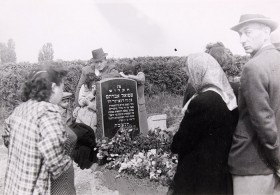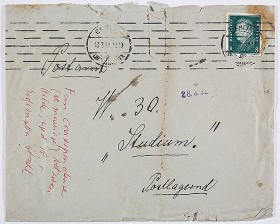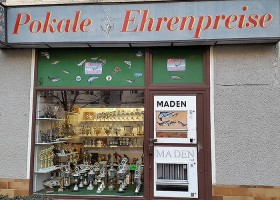Of all the things you can get from a vending machine…
Vending machines sell us a lot of the things we might need (or believe we need) through the day: drinks, sweets, cigarettes, inner tubes for bike tires, toothbrushes, and even anglers’ “supplies.” This last offer surprised me as a non-angler awhile back in the Berlin neighborhood of Wedding, starting with the lovely label “maggots.” I always make sure to take visiting guests by and show them too. As none of them are fishermen, they are always as startled as I was. → continue reading
The Tragic Fate of Shmuel Dancyger Z. L.

The family at the grave of Shmuel Dancyger; Jewish Museum Berlin, gift of Morris Dancyger
During a visit to my hometown of Calgary Alberta, Canada in the summer of 2014, I had the opportunity to meet with Morris and Ann Dancyger, both child survivors of the Holocaust. Morris Dancyger was one of the very few children to have been liberated by the Russians at Auschwitz on 27 January 1945. In the iconic footage of the children displaying their tattooed arms, four year old Morris is in the center of the picture. Ann Dancyger and her mother had miraculously survived an execution in 1942 near the town of Ratno where she was born, and spent nearly three years thereafter in hiding. After a nearly two year trek to Germany following the end of the war, she was able to come to Calgary where relatives lived. I had not known the Dancygers while growing up in the city, and although I had much later read about the tragic fate of Morris Dancyger’s father Shmuel, I was completely unaware that his wife and children had settled in Calgary. → continue reading
An Early April Fool’s Joke from the Year 1931

Envelope posted 13 March 1931; Jewish Museum Berlin, Gift of Margaret Littman and Susan Wolkowicz, the daughters of Hilde Gabriel née Salomonis
Sometimes figuring out how to classify a document correctly according to its historical context can depend on just one tiny, even seemingly unrelated detail. I was reminded of this again while working on the inventory of a recent donation to our archive. With more than 3,000 documents, photographs, and objects, the Gabriel-Salomonis family collection includes among other things an extensive correspondence. This consists of letters, postcards, and even telegrams, and as I sorted through these items, I came across an exchange of four letters from the early spring of 1931. Two were handwritten: composed and signed, quite legibly, by the then 72-year-old, Berlin resident Ernestine Stahl (1858–1933). The author of the other two type-written letters was at first uncertain, not least because his signature was missing. Ernestine Stahl addressed him in her replies only as “Sir” and “Dear Sir.”
I was able to solve this little riddle, however, by looking at an envelope that turned up elsewhere of the bundle of papers but appeared to belong to this brief exchange. → continue reading


